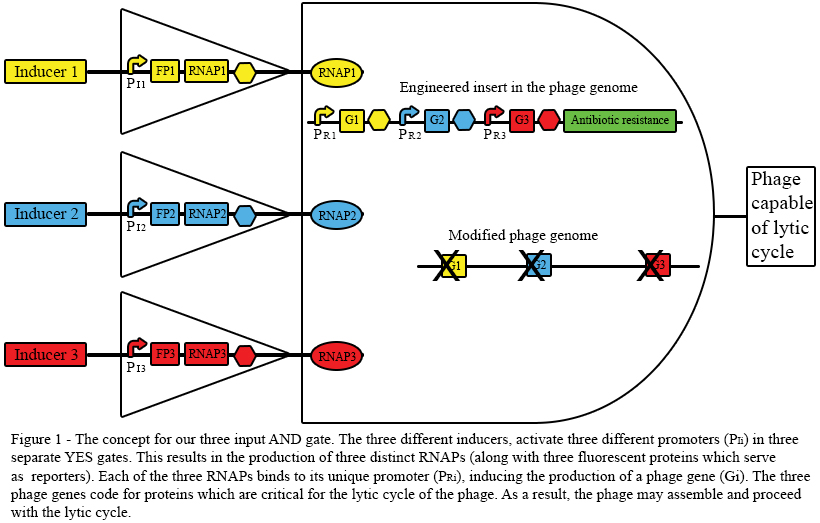Team:Technion/Project/Overview
From 2012.igem.org
(→The inducers, promoters and bacterial strain) |
(→The fluorescent proteins) |
||
| Line 9: | Line 9: | ||
==The fluorescent proteins== | ==The fluorescent proteins== | ||
| - | The choice of compatible fluorescent proteins | + | The purpose of the fluorescent proteins in our system was to verify induction of the various promoters by their inducers. The choice of compatible fluorescent proteins for simultaneous visualization can be tricky. Based on the work done by Tsien, et al {2} we initially chose to use mCitrine (a yellow FP), Cerulean (a cyan FP) and mCherry (a red FP) assigned to P<sub>TetO</sub>, P<sub>Lac/Ara</sub> and P<sub>Lux</sub>+RS. Following different consideration. These considerations are mentioned in the [https://2012.igem.org/Team:Technion/Project/YES_gates YES gates] section. Unfortunately, the mCitrine, which we acquired from Roee, failed to show fluorescence. Therefore, we tried several alternatives which are described in the [https://2012.igem.org/Team:Technion/Project/YES_gates#YES_gate_.232 YES gate #2 section]. |
==The RNA polymerases and promoters== | ==The RNA polymerases and promoters== | ||
Revision as of 18:03, 22 September 2012

Contents |
The general idea
Figure 1 presents the basic strategy for our three inputs AND gate. Each one of the inducers can be an environmental signal, to which the phage will respond. In order to check that the inducers work, we chose to use fluorescent proteins (FPs). The inducers also trigger the production of RNA polymerases (RNAPs), in a logical operation similar to a YES gate. Finally, in the presence of all the inputs, the phage will be capable to resume its lytic cycle, resulting in our AND gate's output.

The inducers, promoters and bacterial strain
When considering the choice of our system's components, the choice of the inducers, promoters and bacterial strain is intertwined. We needed to minimize the number of plasmids used, therefore, the bacterial strain should provide us with as many regulatory overexpressed components as possible. Roee had the strain DH5αZ1, which expresses high levels of Lac and Tet repressor (LacR, TetR) as well as of AraC {1}. This allowed us to use the PTetO and the PLac/Ara promoters without the introduction of additional regulatory elements on plasmids. Consequentially, the inducers used were anhydrotetracycline (aTc) for PTetO and IPTG with arabinose for PLac/Ara.
The choice of the third promoter could no longer rely on host strain expression of required regulatory elements. Therefore, we chose the quorum sensing system based on the PLux promoter, which is induced by 3OC6HSL (also known as N-(β-ketocaproyl)-L-Homoserine lactone) in the presence of the LuxR protein. This made it obligatory for us to express the LuxR gene from a plasmid. Moreover, since the PLux promoter is leaky, we chose to introduce another regulatory element to reduce the basal level. This element is the theophylline induced riboswitch (RS), which controls the level of translation of a given protein. More about these elements can be found in the YES gate #3 section.
The fluorescent proteins
The purpose of the fluorescent proteins in our system was to verify induction of the various promoters by their inducers. The choice of compatible fluorescent proteins for simultaneous visualization can be tricky. Based on the work done by Tsien, et al {2} we initially chose to use mCitrine (a yellow FP), Cerulean (a cyan FP) and mCherry (a red FP) assigned to PTetO, PLac/Ara and PLux+RS. Following different consideration. These considerations are mentioned in the YES gates section. Unfortunately, the mCitrine, which we acquired from Roee, failed to show fluorescence. Therefore, we tried several alternatives which are described in the YES gate #2 section.
The RNA polymerases and promoters
The phage
References
1. Lutz R., Bujard H. 1997. Independent and tight regulation of transcriptional units in Escherichia coli via the LacR/O, the TetR/O and AraC/I1-I2 regulatory elements. Nucleic Acids Research 25(6): 1203-1210.
 "
"